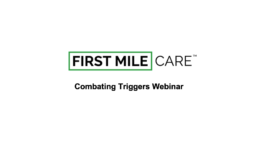Resources for Healthy Eating in National Nutrition Month
By Juliana Ronn, First Mile Care Director of Operations
March is National Nutrition Month! It offers an opportunity to revisit some useful articles and information sources with tips for eating well — and healthily.
Good nutrition is a major component of the clinically-proven National Diabetes Prevention Program (DPP) offered by First Mile Care. Our program enables personalized support and guidance at the community level, giving participants access to the coaching, tools, and resources they need to live healthier lives and reverse or prevent chronic health conditions like prediabetes. Approximately 88 million Americans over age 18 have prediabetes, but 84% of them aren’t aware of it.
The DPP was designed by the Centers for Disease Control (CDC) to help people make more informed choices and lasting changes in their lives. While modest weight loss (about 5%) and modest activity (150 minutes per week) are core goals of the program, the DPP also focuses on nutrition and healthy eating, not dieting. The goal is to create realistic eating habits that you can stick with for the long-term, not just short-term meal plans. Participants learn to eat healthier without giving up the foods they love, even when eating out. Small changes, like awareness of portion sizes, can make a big difference.
Here are a “baker’s dozen” of links to articles about nutrition and healthy eating on the First Mile Care blog, in our “Diabetes Prevention in Action” webinar series, and in other online resources to help you on your journey to a sustainable healthy lifestyle.
1. The U.S. Department of Agriculture (USDA) has a robust website with advice on nutrition choices and links to a wealth of resources related to healthy eating, including MyPlate, the USDA food group guide.
2. Coach Irazema Garcia offers her advice on the First Mile Care blog on how to plan and prepare a menu of healthy meals without feeling overwhelmed.
3. The HuffPost has a useful section on food that recently quoted Coach Jenny Fowler in an article about how to avoid confusing serving and portion sizes of many popular foods.
4. Coach Kathy Gregory discusses on Thrive Global how important good nutrition is to your workout performance and results.
5. Yes, the DPP lets you bake desserts and other goodies in a healthy way — just follow Coach Sandra Huskey’s advice.
6. Have you ever wondered if it’s OK to eat the same foods, day after day? Eat This, Not That! interviewed Coach Jenny Fowler on getting the right blend of stability and variety in your diet.
7. Everyday Health is a blog that is full of consumer-friendly health and wellness content.
8. Coach Irazema Garcia’s recipe for cauliflower makes it a healthy yet still-delicious side dish.
9. Well+Good is a popular lifestyle blog with a lot of tips on healthy eating, including comments from Coach Kathy Gregory on coping with grocery-store shortages.
10. Coach Jenny Fowler provides advice for eating “smart” at holiday meals and other gatherings focused on food.
11. Keeping a food journal is a useful way to discover how eating habits are connected to your moods, says Coach Karalyn Cass.
12. Learn about the link between your eating habits and mental health in this article on Incredible Edibles that includes Coach Kathy Gregory among the experts offering advice.
13. The Wall Street Journal talks about foods that can help fight stress, anxiety, and depression, while Coach Jenny Fowler offers tips on the First Mile Care blog for breaking the link between stress and eating.
To learn more about how you can benefit from the First Mile Care Diabetes Prevention Program, take the prediabetes risk test and get started today!
Total Health: Karl Ronn of First Mile Care On How We Can Optimize Our Mental, Physical, Emotional, & Spiritual Wellbeing
First Mile Care CEO Karl Ronn shares tips on how we can optimize our mental, physical, emotional, & spiritual wellbeing.
Read more via Authority Magazine >
Mind(set) Over Matter
First Mile Care DPP Coach Bibilola Ladipo-Ajayi shares the importance of the right mindset to achieve health goals. She explains that we are all vulnerable and often succumb to unhealthy thought patterns, which can impact our ability to make the small, sustainable habit changes that result in a healthier lifestyle. Read more on Thrive Global >
10 Foods With Serving Sizes That Are Way Smaller Than You Thought
First Mile Care DPP Coach Jenny Fowler gives tips on serving sizes. She says that eating more than one serving of any given food on occasion isn’t something to worry about, as long as you’re doing it mindfully and considering your dietary needs.
Mind(set) Over Matter
By Bibilola Ladipo-Ajayi, First Mile Care DPP Coach
The Cambridge dictionary defines the phrase “mind over matter” as “the power of the mind to control and influence the body and the physical world generally.” As part of the First Mile Care ongoing series on “Diabetes Prevention in Action” webinars, I highlighted the impact that your mindset has on your ability to make the small behavioral changes that can reduce or reverse your prediabetes status over time.
The National Diabetes Prevention Program (DPP) curriculum covers a variety of healthy practices such as healthy eating, meal planning, and fitness. It also highlights the importance of stress management and mindfulness. Having a “growth mindset” helps you achieve the goals you set for yourself in your DPP action plan and empowers you to keep making progress towards sustainable habit changes.
We are all vulnerable and often succumb to unhealthy thought patterns. It’s important to recognize which specific ones you are at risk for, because consistent negative thought patterns can lead to a destructive mindset. Some common unhealthy thought patterns include: all-or-nothing thinking; overgeneralization; disqualifying the positive and downplaying accomplishments; jumping to conclusions; and magnification or minimization of positive or negative traits. Others include labeling and mislabeling behaviors (which can become self-fulfilling prophecies); personalization (when everything is your fault or responsibility); and mental filters (when you focus on negative things and filter out positives).
Being of two mind(set)s
Your mindset has a big impact on your success in life — career, relationships, and health goals. Stanford University psychology professor Carol S. Dweck, Ph.D, is a leading researcher of mindset and its connection to motivation and success. In her best-selling 2007 book, Mindset, The New Psychology of Success, she explores the two main mindsets linked to human potential: fixed and growth mindsets.
She explains that a fixed mindset leads to a defeatist attitude focused on failure and making excuses for lack of success. A person with a fixed mindset believes that skills are innate, something we are born with, and as such, learning new skills is of no value and impossible. A person with a fixed mindset often avoids challenges and rejects any kind of feedback that may suggest there is room for improvement. They also compare themselves with other people, feel threatened by the success of others, and are less likely to celebrate or collaborate with people. This kind of static mindset keeps a person in a cycle of defeat, focused on reproducing only what they already know. The outcome is a life of barrenness and the inability to evolve or grow.
On the other hand, Dweck describes the growth mindset as one that focuses on developing skills through hard work and effort. Although people may be born with certain talents, skills can be acquired and refined. This mindset emphasizes the value of investing effort and therefore encourages feedback, because it is viewed as an opportunity to learn and improve. A person with a growth mindset embraces challenges and celebrates personal achievements and those of others. Failure and mistakes are not viewed as evidence of lack of intelligence, but instead as stepping-stones on a path to growth and the stretching of existing abilities.
Developing a growth mindset
One detrimental way that a negative mindset impacts living a healthy lifestyle is expressed when people feel stuck with regards to achieving their health goals. At certain stages in life, which could often be age-related, it is so easy to believe that nothing new or good can happen, especially if you have struggled with significant health challenges. You can become vulnerable to unhealthy thought patterns like “I’ll never lose weight now, so what’s the point of trying?” or “It’s too late to learn to play tennis/golf/swim/ski.” An accumulation of these unhealthy thoughts could translate into unhealthy behaviors and lead you farther away from achieving your health goals.
So how do you develop a growth mindset and take practical steps to achieve your health goals? I am glad you asked. These steps below (in no particular order) are worth a try.
- Renew your mind. A Google search on “brain plasticity” explains how scientific research proves that your brain is wired to grow and learn regardless of your age. Get curious about the world around you and study. It might motivate you to explore and discover new things!
- Acknowledge and embrace imperfections. Practice self-awareness which helps you identify your strengths, weaknesses, and growth areas. There is no need to criticize yourself for not being perfect; no one is perfect. Self-awareness is a gift that you can give to yourself and the people around you.
- View challenges as opportunities. Recognize that mistakes and failure can be an opportunity for improvement rather than a reflection on you as an imperfect or inadequate person. Use them wisely.
- Pick your tribe. It is important to surround yourself with like-minded people. Be intentional about who has access to your mind space. In addition, the books you read, the shows you watch (news, social media), and the music you listen to, all impact what kind of mindset you nurture, so choose wisely.
- Change your vocabulary. Use the words “I’m learning” to do something rather than “I’m failing.” Use “yet” more often, as in saying, “I haven’t done it yet” or “I haven’t been successful yet.”
- Value process over results. Try to focus more on the journey and all the discoveries you can make during the process, and not on the destination alone. This can also help you hone your skills in being more present.
- Be realistic about time and effort. You most likely will not master everything or achieve your goals all at once or immediately. Be patient with yourself and the process of learning or starting something new.
- Cultivate grit. Don’t get overwhelmed by aiming for perfection. Aim for continuous excellence and let your measure of success be that you are better than you were yesterday. You walked more steps today than yesterday, or tracked your meals for three days straight versus just two days.
- Make new goals. Set new goals or refine existing goals. When you accomplish one goal, push yourself to go higher and do better. Keep moving forward!
- Cultivate a sense of purpose. Desire to leave a legacy that influences others to achieve their goals as you achieve yours. Even without speaking, you are a person of influence to your coworkers, friends, and family, whether you believe it or not.
- Take ownership of your attitude. As you develop a growth mindset and recognize the life-changing benefits, be proud of it, celebrate it, and go on to Inspire others.
Listen to the recording of my presentation to learn more about how you can improve your mindset to help you on your road to a healthier (and more satisfactory) lifestyle.
To learn more about how you can benefit from the First Mile Care Diabetes Prevention Program, take the prediabetes risk test and get started today!
What’s Triggering Your (Unhealthy) Behaviors?
First Mile Care DPP Coach Irazema Garcia shares how to identify your cues, routines, and rewards in order to make lasting habit changes. Adjusting your triggers can set you free of your negative behaviors. But first you have to figure out how your triggers are built. Learn more from Thrive Global >
What’s Triggering Your (Unhealthy) Behaviors?
By Irazema Garcia, First Mile Care DPP Coach
The National Diabetes Prevention Program (DPP) helps participants learn to make small, sustainable behavioral changes that, over time, will have positive health benefits and reduce or reverse their prediabetes status. As part of the DPP curriculum, First Mile Care offers an ongoing series of “Diabetes Prevention in Action” webinars that cover a variety of healthy practices in not only eating and meal planning, but fitness, stress management, mindfulness, motivation, and behavioral triggers.
By triggers, I mean a stimulus, an activation point, a flashback, a reminder, or a reaction. A trigger gets the ball rolling towards taking an action which could have a positive or negative result. Unfortunately, triggers can sometimes get in the way of achieving goals you’ve set for yourself in your DPP action plan. So, if you can identify your triggers and understand them better — why you do what you do and when — you may be able to overcome the obstacles triggers create and keep making progress towards habit changes that are going to last not just months, but years.
Adjusting your triggers can set you free of your negative behaviors. But first you have to figure out how your triggers are built.
Trigger = Cue + Routine + Reward
A trigger has three parts: the cue, the routine, and the reward:
- Cue: The spark that sets off an action. A cue can be an event (e.g., Thanksgiving, a birthday party); a place (e.g., a movie theater makes you want popcorn); a person (e.g. you and your best friend always have coffee together), or an emotion (e.g., you do X when you’re sad, lonely, tired, or angry).
- Routine: The action that you take as a result of the cue. For example, buying popcorn simply because you’re in the movie theater; drinking coffee because you are with your friend; pouring a glass of wine because you’re alone at home.
- Reward: The satisfaction that you get from that routine, whether it’s the feeling of nostalgia every time you eat movie popcorn, or the joy you get from meeting your friend. The reward is what you’re really searching for. As humans, we want that gratification.
Finding a substitute routine
A very common trigger is to eat when you’re bored because it gives you something to do — even though you may not be physically hungry. In this case the cue is boredom — it kicks off the behavior. The routine, or action, is to eat a snack. The true reward for eating is not the snack (because you’re not physically hungry) but that you are no longer bored (at least for the time that you’re eating). The act of eating relieves the boredom you are facing.
So, what can be done when boredom strikes? One thing is to substitute the routine (eating) that stems from your cue (boredom) BUT will still give you the reward you seek (not being bored). Switching out the normal routine with a new one that can reinforce your goals can help you achieve success.
For example, when you feel bored (the cue), you can try a new routine: go for a walk or read a book. Call a friend. Rearrange your closet or spice rack. The important thing is to establish a new action to substitute for the old one (eating). Your reward will still be that you’re no longer bored, because going for that walk (or reading that book, or calling that friend) is keeping you busy and thus, ending your boredom.
What your brain wants is the reward. The action isn’t as important.
Getting your reward
Oftentimes when you try to deal with a trigger, especially related to eating, you try to go cold-turkey and eliminate the routine. You deny yourself through sheer willpower. You feel the cue (boredom), but decide not to take any action. What ends up happening? You don’t receive the reward you were after.
“I am bored but I will not eat anything,” you vow. However, not eating anything is not a remedy for boredom. Your brain tries to figure out what the reward is in not eating, and most often cannot find one. As a result, you’re not satisfied. You’re still bored. And so what often happens is that you continue to seek that reward, and no matter how many times you tell yourself you will not eat, you end up eating (sometimes even more than you desire) in order to find that reward. That’s why it’s very challenging to eliminate a routine without finding an adequate substitute. For long-term success, you’ll need a new routine to substitute for the old one.
Watch my webinar below and think about what your triggers are, for both positive and negative behaviors. What new routines can you find for actions so you still get the rewards you desire?
To learn more about how you can benefit from the First Mile Care Diabetes Prevention Program, take the prediabetes risk test and get started today!
What Happens to Your Body When You Eat The Same Foods Every Day
First Mile Care DPP Coach Jenny Fowler shares a shortcut for healthy eating: to make your plate as colorful as possible.
“For example, vitamin A can be found in orange foods such as butternut squash and carrots, while a good source of vitamin K is dark, leafy greens like kale,” explains Jenny Fowler, a nutrition consultant and Diabetes Prevention Program (DPP) coach with First Mile Care. “On the other hand, while grains have some variety of nutrient composition, they are all high in the B vitamins so you don’t need to pay as much attention to grain variety.” Read more from MSN >
What Happens to Your Body When You Eat The Same Foods Every Day
First Mile Care DPP Coach Jenny Fowler shares a shortcut for healthy eating: to make your plate as colorful as possible.
Read more from, Eat This, Not That! >
Making Home Workouts More Enjoyable and Successful
First Mile Care DPP Coach Sandra Huskey shares her ideas on making home workouts more enjoyable. When it comes to setting fitness goals, we need to be realistic and focus on one or two small goals. Learn more from Thrive Global >










